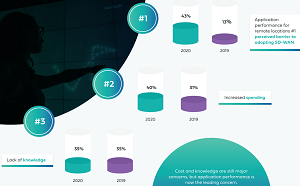News
Application Performance Is Top Barrier to SD-WAN, Report Says
Cloud wide-area networking (WAN) specialist Aryaka has published a new report that reveals application performance is the top barrier to the adoption of software-defined wide-area networking (SD-WAN) technology.
The company announced the report yesterday (April 22), stating it "reveals application performance, impacted by network complexity at the edge and in the cloud, is the key enterprise concern this year for organizations implementing SD-WAN."
Aryaka, which sells a managed SD-WAN solution and describes itself as a cloud-first WAN company, covered the burgeoning software-defined movement and much more in its fourth annual "State of the WAN" report, based on a survey of more than 1,000 global IT and network practitioners at enterprise organizations headquartered in North America, Asia-Pacific (APAC) and Europe, the Middle East and Africa (EMEA).
After the application performance issue (reported by 43 percent of 988 respondents), which the survey report described as "a major bump from previous years," the top barriers were knowledge gaps (40 percent), increased spending (35 percent) and additional complexity (34 percent), which was tied with "it's still very new technology."
 [Click on image for larger view.] Top SD-WAN Barriers (source: Aryaka).
[Click on image for larger view.] Top SD-WAN Barriers (source: Aryaka).
In covering SD-WAN concerns, the report also details data on security, application performance and artificial intelligence/machine learning.
"A common theme is application performance, hostage to complexity, skills gaps, and the set of diverse services expected to be supported by a WAN that is expected to be a catalyst for Digital and WAN Transformation," the report's executive summary states.
Year-over-year observations observed in the report include:
- Complexity impacts peformance: Complexity (37 percent) is the new leader, growing from 35 percent in 2019 and only 13 percent in 2018. This ultimately leads to poor application performance for both on-prem (32 percent) vs 23 percent, and cloud apps (32 percent) vs 24 percent. It replaces cost, dropping from 40 percent in 2019 to 16 percent in 2020.
- Addressing application performance issues: Application performance continues to be the biggest area of investment of time for IT organizations. This spans remote workers (47 percent), growing from 36 percent in 2019, the branch (43 percent), down from 45 percent, and integration of cloud and SaaS application origins (42 percent), growing from 20 percent. Evidence is that remote workers are placing additional burden upon the network.
- Unified communications as-a-service a perennial challenge: Set-up and management (48 percent) is the new top challenge, growing from 28 percent in 2019. �is replaces poor voice or video as well as lag/delay as the top concern, highlighting both complexity and network performance.
- Automation is key: IT departments plan to invest in automation (41 percent), which is the new leader, growing from 31 percent in 2019. Cloud migration moved from 31 percent to 36 percent, analytics from 28 percent to 33 percent, and security dropping from 34 percent to 30 percent.
- Security and SD-WAN converge: 54 percent look to multiple vendors for the edge, but only 44 percent in the cloud. CIOs want end-to-end security with hybrid flexibility, with deployment at the edge or in the cloud, and with the ability to leverage their existing vendors.
- Enter 5G: 42 percent are looking to invest in 5G, followed by IoT at 29 percent, AI/ML at 27 percent, and Blockchain at 21 percent. 5G is receiving interest as a potential primary form of SD-WAN connectivity.
- Remove SD-WAN barriers: SD-WAN application performance is now top-of-mind, at 43 percent vs 13 percent in 2019, followed by the skills gap (40 percent) vs 31 percent, increased spending (35 percent), the previous leader, and additional complexity (34 percent) vs 25 percent.
Readers can access the report, which lists the full methodology, by going here.
About the Author
David Ramel is an editor and writer at Converge 360.